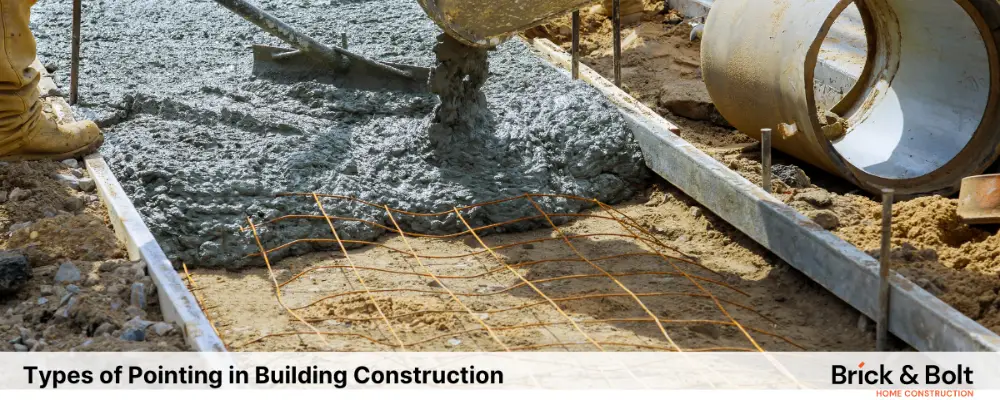Building construction is a unique blend of art and science, where creativity and skillful knowledge is utilised to transform ideas into physical structures. Constructing a building needs meticulous planning, skilled craftsmanship, technology and coordination among collaborative engineers and architects. Numerous techniques are used in construction to ensure the stability and durability of built structures. One such technique is pointing for masonry.
In this article, we shall explore various types of pointing in construction, its benefits and purpose.
Types of Pointing Based on Shape and Finish
Various techniques are used in pointing in construction. Each type has its own distinct fascinating appeal and functional convenience. Following are some of the prominent types of pointing used in building construction:
1. Flush Pointing
Flush pointing is a widely used method that can create a smooth and levelled surface on the wall. In this technique, the gaps between the masonry blocks are carefully filled with mortar by hard pressing and then, the mortar is smoothed out to remove excess mortar. Once the mortar joint is pressed flush with the surface of the wall, it gives an aesthetically pleasing appearance. However, it may not be very effective in diverting water away from walls.
2. Recessed Pointing
In this type, using a suitable tool, the mortar is pressed into the joints of a wall and creates a depth of around 5 mm from the edges, while the face of the pointing remains vertical. .
3. Tuck Pointing
Tuck pointing is a precise style of pointing in which the mortar is forced into the raked joints and creates a groove that is typically 5-10 mm in width and 3-10 mm in depth. This technique is time-consuming and requires skilled labour.
4. Beaded Pointing
Once the mortar is pressed into the joints of the wall, a concave groove is formed with an iron or steel tool with a concave shape. This results in a distinctive appearance known as beading, and creates an elegant visual appeal. This type of pointing is easily vulnerable to damage due to its projected surface.
5. Struck Pointing
Struck pointing involves two steps. First, the gaps are filled and pressed to achieve a smooth face of the masonry. Next, the lower edge of the raked joint is pressed inward to form a sloping or inclined slope of about 10mm to drain rainwater rapidly.
6. Rubbed, Keyed or Grooved Pointing
Rubbed, keyed or grooved pointing is a sort of mortar joint in which mortar is forced into joints with a pointed tool to create a curved arc groove like a series of keyways. These keyways are commonly used in locking the masonry pieces and it provides a stronger vertical joint of the wall. It can withstand any weather condition and gives an aesthetic appeal.
7. V-Grooved Pointing
V-Grooved pointing is a construction technique which is similar to keyed pointing work. Here, the mortar is pressed and filled into the joint, establishing a flush finish. A specialised V-shaped instrument is then inserted to the joints to create a V-shaped groove.
8. Weathered Pointing
This is similar to struck pointing. However, instead of the lower edge, the upper edge is pressed backwards to create sloped pointing joints.
Types of Pointing Based on Materials Used
Cement Mortar Pointing: Cement mortar pointing primarily consists of cement, sand, and water. It is known for its durability and resistance to weathering, which prevents water ingress. Properly executed pointing protects the structural integrity of the masonry.
- Lime Mortar Pointing: Lime pointing is a traditional technique used in historical buildings as it employs lime-based mortars, which are preferred for their compatibility and their ability to allow structures to breathe. It involves filling and finishing the joints between masonry blocks with mortar made from lime, sand, and water. This technique is essential for maintaining the structural integrity and aesthetic appearance, as it allows moisture to move through solid-walled structure, reducing the risk of damage from trapped moisture.
- Pointing with Paint:Pointing with paint refers to the application of a specific paint that imitates the appearance of traditional mortar pointing. It can be used for both ceilings and woodwork in traditional settings, and is designed to mimic the soft, light, and warm undertones of lime pointing. It generates attractive spaces when used on walls and always softens the look of a room.
- Sand Pointing: In this technique, a sand-based mortar is used to fill and finish the joints between masonry blocks to give a smooth surface. This method is particularly beneficial for enhancing the overall aesthetic appearance. It also contributes to longevity as it acts as a resistance to weathering and erosion.
Conclusion
In summary, pointing is a vital technique in masonry construction that offers durability, enhances the overall aesthetic value, and increases overall structural integrity. It provides an effective and essential protection against environmental elements. It also increases the value of your property and provides a desirable outcome. Consult your architect or contractor to incorporate the right type of pointing for your next masonry construction.

